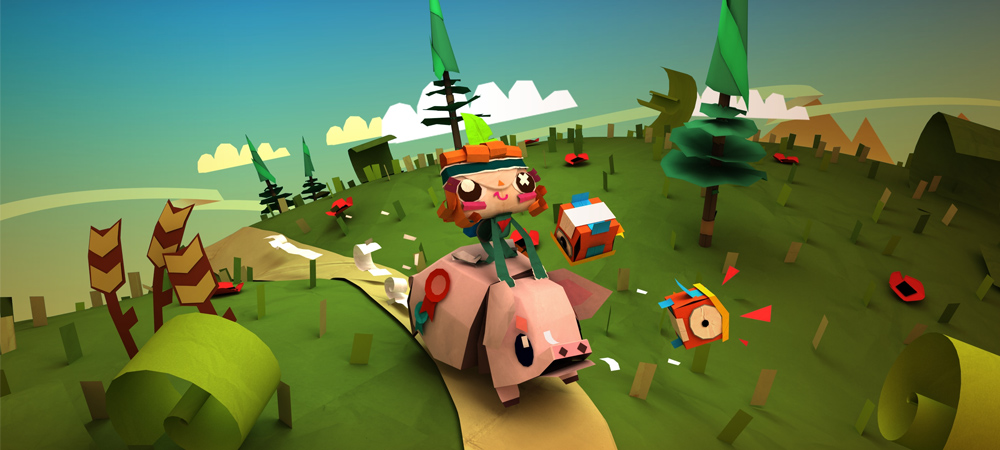Interview with lead creator Rex Crowle
Earlier this month, I caught up with Media Molecule’s Rex Crowle, lead creator on one of my favorite games of last year, Tearaway. My main goal was simple: to thank him for such a fantastic Vita game. But we ended up chatting about Tearaway‘s reception, as well as some of the challenges that Media Molecule had to work through to bring us the final release.
I also repeatedly told him that they should make another Tearaway game.

After thanking Crowle for Tearaway, I asked him how he thought the game fared. The Vita platformer was well received, and made it onto many Game of the Year lists last year. We loved it.
“I’ve kind of been pleasantly surprised how well it has connected with people,” Crowle told Destructoid. “Kind of more than I thought it might. It was kind of a risk to rely on it pressing the special feelings button on people. It’s very hard to judge whether that is working until you’re done.”
“Obviously we’re kind of known for making charming games that people make some connection with. But with this one I really wanted to go a little bit deeper. It’s not just whimsical, there’s more of an arc in what happens with reuniting yourself with the in-game character, and with the ending and all of that stuff.”

Tearaway garnered early attention from its distinctive visuals, which were built with Media Molecule’s custom game engine. But this came engine only after trying other solutions; none of them worked for what they were trying to do with Tearaway‘s folded-paper look.
“It was difficult in the early period where so much of it hinges on the paper engine. It was all custom built and there was no way we could use anything existing,” said Crowle.
“We had a prototype engine to try out ideas, which was kind of an isometric thing. But it just pushed us in the wrong direction. It was just wasted time to try to make anything in that engine.”
Crowle continued: “If you’re making a game out of paper it just looks like cubes. It was only when we actually had managed to get it far enough along that we were all given our sheets of virtual paper and could all start cutting and folding, that’s when it really… well, the first fold was a revelation.” [head explosion hand gestures]

I told Crowle that I think the game’s box art didn’t seem to serve the game; it didn’t reflect how unique Tearaway really is. The artwork is nice, but any static screenshot of the game as a cover would probably have served the game better.
Crowle whispered, “I didn’t like the cover.”
“I think what’s fun is seeing how we gradually subverted what someone might think they’re getting. I think a lot of people have been surprised, thinking it’s the kind of you know, the old THQ or Disney tie-in. It’s got kind of a young appeal to it. And actually, when they start playing, they’re like whoa. Straight off, you’re being asked how you want to be identified, not just the sort of pink and blue boy/girl buttons or things like that.”

One of the neatest aspects of Tearaway is that you can earn papercraft projects as in-game rewards. You’re able to print these and assemble them, adding your own touches along the way. Crowle recalled what they were going for with this choice.
“We try to create these loops in game design, feeding into another thing. But, ultimately, they are all just digital things, and they don’t mean anything really,” Crowle said.
“I think it’s also not just that you get it out, but you’ve got to make it yourself. So it’s going to look a bit different. When we were experimenting earlier on, and the game wasn’t looking as good as it could, it was a really good moment to just get everyone to make squirrels. And although everyone was making the same plan, everyone had put the eyes slightly different. Some people had used too much glue, and others not enough. Even though we all started with exactly the same template, they all looked subtly different. And that really helped us get the look.”

I asked Crowle if they considered other external interactions for Tearaway, suggesting that some kind of musical tie-in would have been great. This had him recalling something he wanted to do, but ultimately couldn’t implement.
“Something I really wanted to put in the lab section was the idea of the way you could encode information into paper,” he explained. “Not by writing on it, but with the old hole punches. And also the player piano rings. I really wanted to be able to punch holes in paper and then print them out and make music with them. That was pretty out there as an idea to try to tell everyone to go spend an extra six months on that.”

With as well as Tearaway was received, I asked if Media Molecule would consider making another game along these lines. He seemed to want to keep as vague as possible in his answer.
“We put a lot of work into it. I think what we’ve made is a complete thing it’s not like it’s a to-be-continued kind of thing. But, obviously, we want people to see it.”
As we ended our talk, Crowle said that Media Molecule is really pleased at how well Tearaway was received, and mentioned how much they enjoy seeing messages from fans online.
“It has been interesting going online in a weird, stalkerish way, reading everything that everyone has been saying.”
“It’s really cool to see the love.”








